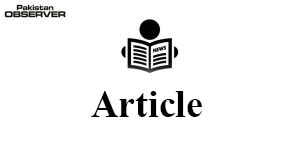Improving quality in education
EDUCATIONAL decline is one of the most-talked-about issues. The discourse as to the sector highlights the hindrances towards educational advancement. To remove these, every so often certain measures are taken at governmental level.
Such measures, for example, include increasing budgetary funds, establishing new schools, providing basic facilities in schools, efforts for bringing out-of-school children into schools, employing bio-metric attendance to ensure presence of teachers and so on.
These steps may be beneficial in one way or the other. However, there are some educational predicaments, which if not problematised, may hinder the materialisation of qualitative education.
One such predicament is the prevalent high student-teacher ratio in schools. The Student-Teacher ratio is a crucial indicator of learning environment in classrooms.
Lower the ratio the more conducive learning environment would be. Most of classrooms in public schools, especially in Sindh province, are over- crowded, having more than 100 students enrolled.
To reduce the number of out-of-school children, those at the helm, without taking simultaneous correlative measures for alleviation of the probable accompanying effects, have adopted the policy of enrolling more and more children.
Resultantly, classrooms have become jam-packed. Such classes has its own set of issues: teachers do not find themselves able to attain the set Standard Learning Objectives (SLO); more of teachers’ time is consumed in maintaining discipline; four to five students are made to sit on three-seat bench which cause it difficult for students to concentrate; teachers fail to identify each individual’s strengths and weaknesses, and tailor teaching according to their needs.
On the whole, quantitative classrooms create hindrances for promotion of qualitative education.
Without problematising the issue and subsequently taking measures for reducing the students’ enrolment, any expected change can not be brought about in the field of education.
Another academic matter subjected to less significance is the role of parental involvement in learning.
Parental involvement, as has been proved by many studies, produces positive effects on learning of children and helps in improving their academic grades.
Here teachers are thought to be solely responsible for academic performance of students, whereas responsibilities of parents in this context are somehow over-looked.
Being an educator, I have witnessed that the relatives of just 5-10 students, in a classroom of 100-plus students, come to inquire about the academic performance of their children.
While others do not even bother to visit the school and meet their children’s teachers. Their disengagement influences the learning of their children.
If promoted ,the involvement of parents in education can be helpful in diverse ways; (1) the attendance of students in classrooms will improve when the parents will accompany their children towards school (2) learning outcomes in classrooms will improve when students come to know that their parents are in interaction with their teachers as to inquiring their performance (3) behaviour of students will get reformed when they know that their attitude at school and at home are being monitored by their teachers and parents through interaction between themselves (4) the performance of teachers and school administration will likely improve as they will have to satisfy visiting parents on matters relating to the learning of children .
In an attempt to fostering learning, one of the most helpful factors is the promotion of the trend of parental involvement in education that is significantly missing.
Assessment is also an invaluable aspect of education requiring prioritised focus. Sadly, it has not been attached that importance particularly in public schools.
Teachers remain obsessed with completing the course material overlooking the level of understanding and learning of students.
Their focus remains on pleasing the school administration, by covering more and more topics of the assigned syllabus.
The administration on its part, in order to escape the fury of any visiting officer, tries to ensure that in every classroom enough course material remain covered and with this end in view pressurises teachers.
In all this, what is lost is very much needed focus on evaluating the understanding and learning of students.
For students and teachers education becomes the name of keeping completed the fair notebooks of different subjects and nothing more.
Unless the appraisal and assessment of the learning of students in classrooms is sufficiently valued and pursued, the true aim of education, that is enhancing knowledge and skills, can not be attained.
Teachers will be better able to impart knowledge if they are aware of the weaknesses and strengths of their students. And this can be ascertained through conducting assessment activities in classrooms.
Remaining focussed on completing the syllabus is a good thing, but at the cost of the time of assessment it is certainly not.
The efforts for educational advancement will derive intended results only when all relevant issues and problems are pinpointed and managed.
Most of the times, measures taken for reforming education do not take into account important factors and that spoils positive outcome of such measures. The need is to problematize such issues and take steps for mitigation of their effects.
Lowering the teacher-student ratio, enhancing parental involvement in education and increasing assessment activities in classrooms will surely help in begetting the standardized system of learning.
—The writer is an educationist and academic researcher, based in Larkana, Sindh.










